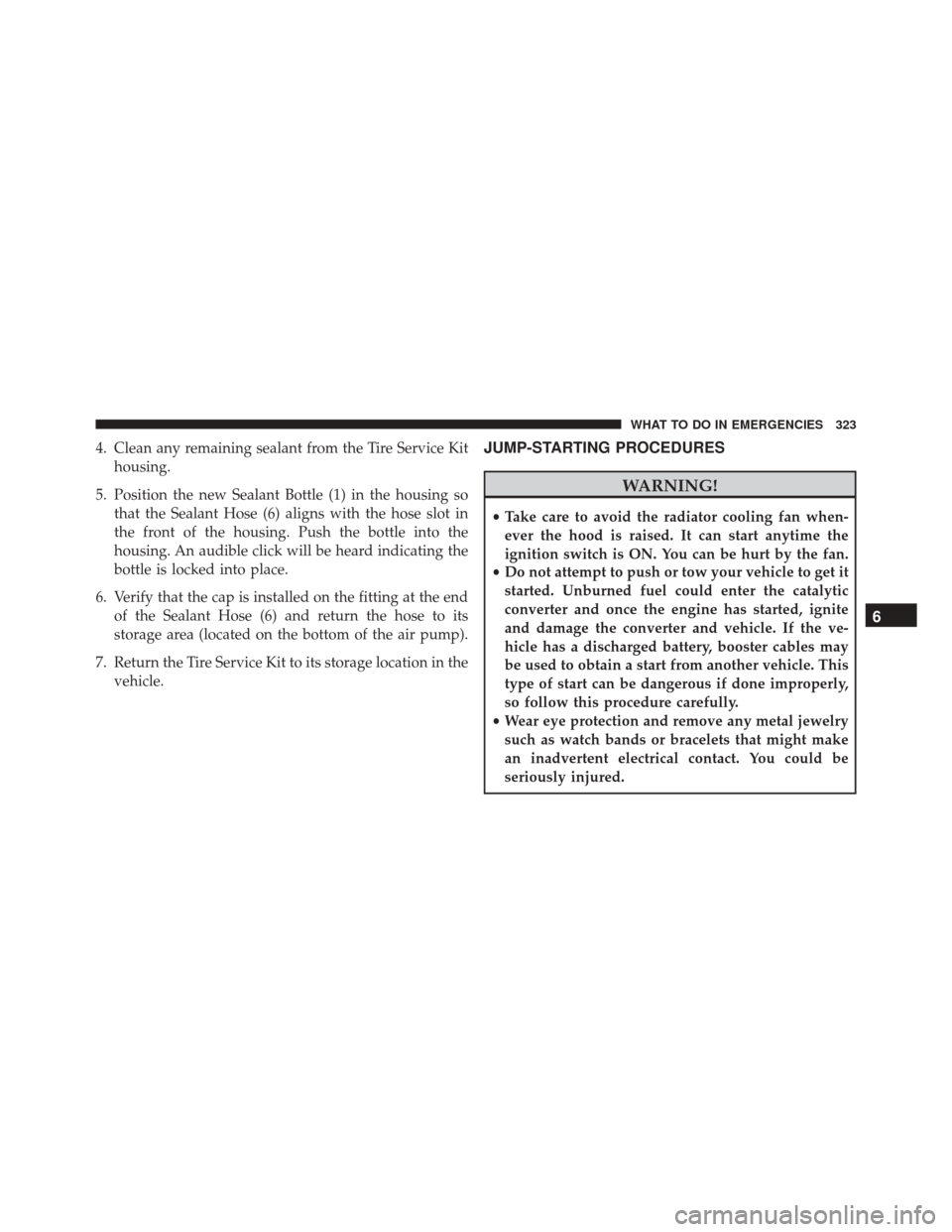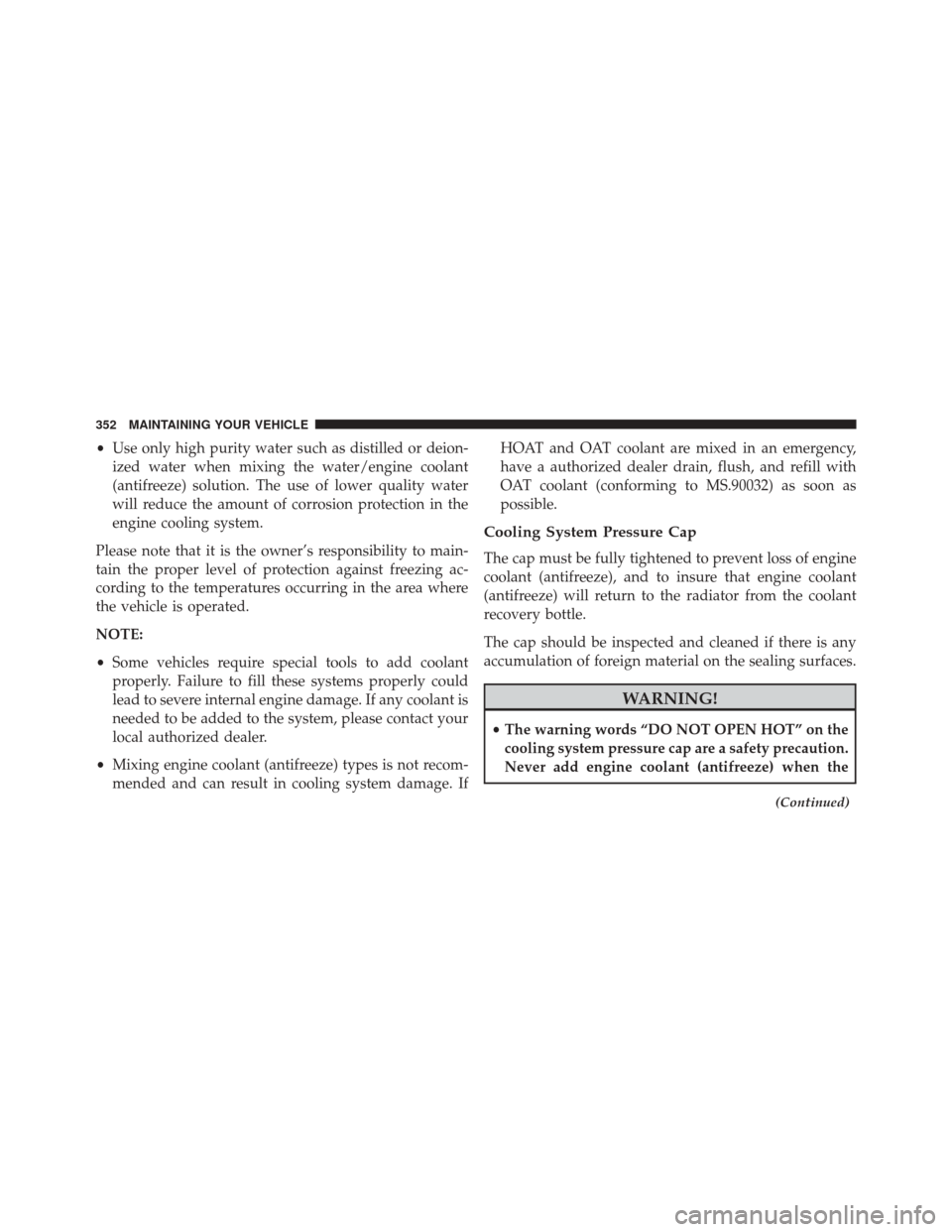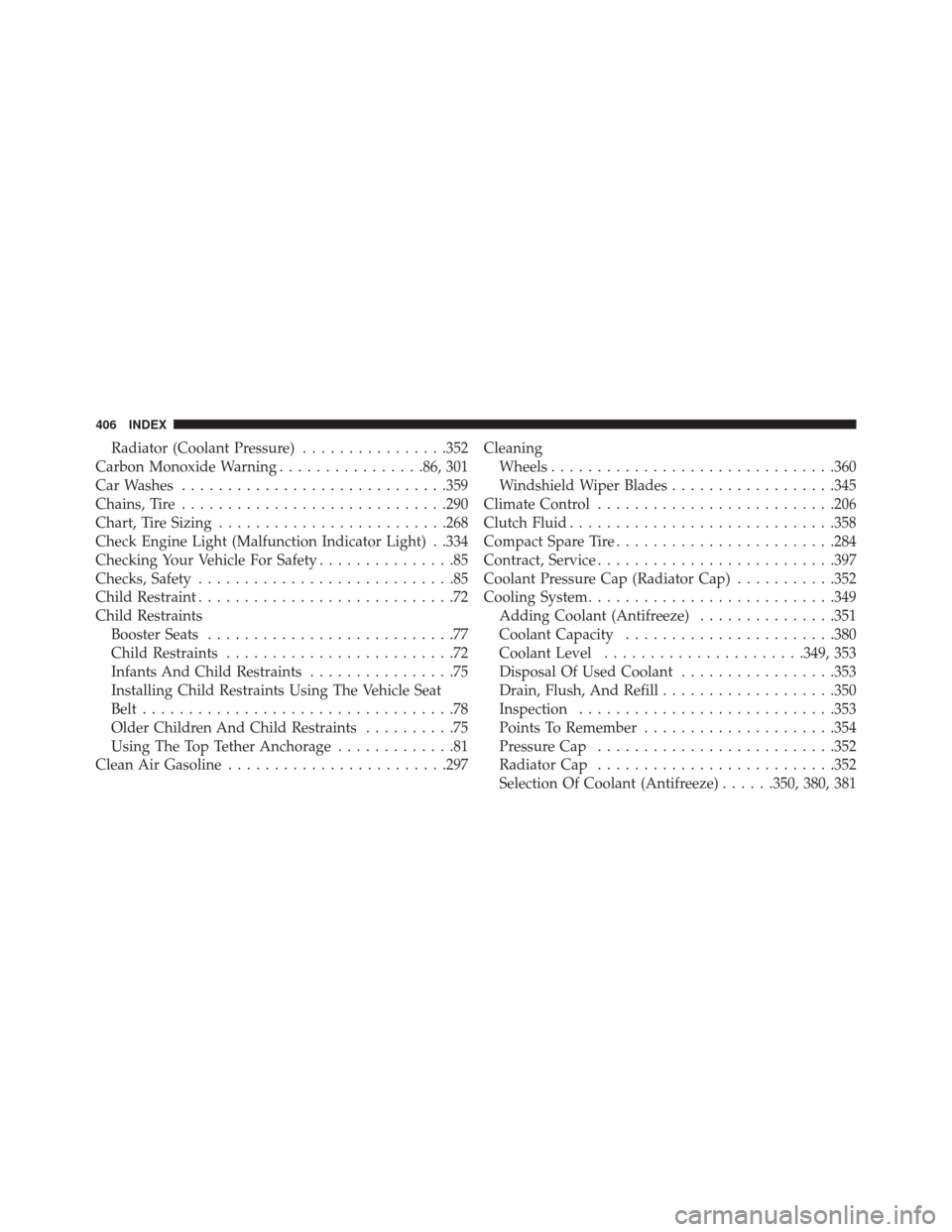radiator cap DODGE VIPER 2016 VX / 3.G Owners Manual
[x] Cancel search | Manufacturer: DODGE, Model Year: 2016, Model line: VIPER, Model: DODGE VIPER 2016 VX / 3.GPages: 423, PDF Size: 2.75 MB
Page 313 of 423

•If your air conditioner (A/C) is on, turn it off. The A/C
system adds heat to the engine cooling system and
turning the A/C off can help remove this heat.
• You can also turn the temperature control to maximum
heat, the mode control to floor and the blower control
to high. This allows the heater core to act as a
supplement to the radiator and aids in removing heat
from the engine cooling system.
WARNING!
You or others can be badly burned by hot engine
coolant (antifreeze) or steam from your radiator. If
you see or hear steam coming from under the hood,
do not open the hood until the radiator has had time
to cool. Never try to open a cooling system pressure
cap when the radiator or coolant bottle is hot.
WHEEL AND TIRE TORQUE SPECIFICATIONS
Proper lug nut/bolt torque is very important to ensure
that the wheel is properly mounted to the vehicle. Any
time a wheel has been removed and reinstalled on the
vehicle the lug nuts/bolts should be torqued using a
properly calibrated torque wrench.
Torque Specifications
Lug Nut/Bolt Torque **Lug Nut/ Bolt SizeLug Nut/
Bolt Socket Size
107 Ft-Lbs (145 N·m) 1/2” x 20 19 mm
**Use only your Authorized Dealer recommended lug
nuts/bolts and clean or remove any dirt or oil before
tightening.
Inspect the wheel mounting surface prior to mounting
the tire and remove any corrosion or loose particles.6
WHAT TO DO IN EMERGENCIES 311
Page 325 of 423

4. Clean any remaining sealant from the Tire Service Kithousing.
5. Position the new Sealant Bottle (1) in the housing so that the Sealant Hose (6) aligns with the hose slot in
the front of the housing. Push the bottle into the
housing. An audible click will be heard indicating the
bottle is locked into place.
6. Verify that the cap is installed on the fitting at the end of the Sealant Hose (6) and return the hose to its
storage area (located on the bottom of the air pump).
7. Return the Tire Service Kit to its storage location in the vehicle.JUMP-STARTING PROCEDURES
WARNING!
•Take care to avoid the radiator cooling fan when-
ever the hood is raised. It can start anytime the
ignition switch is ON. You can be hurt by the fan.
• Do not attempt to push or tow your vehicle to get it
started. Unburned fuel could enter the catalytic
converter and once the engine has started, ignite
and damage the converter and vehicle. If the ve-
hicle has a discharged battery, booster cables may
be used to obtain a start from another vehicle. This
type of start can be dangerous if done improperly,
so follow this procedure carefully.
• Wear eye protection and remove any metal jewelry
such as watch bands or bracelets that might make
an inadvertent electrical contact. You could be
seriously injured.
6
WHAT TO DO IN EMERGENCIES 323
Page 351 of 423

Cooling System
WARNING!
•When working near the radiator cooling fan, dis-
connect the fan motor lead or cycle the ignition
switch to the LOCK position. The fan is tempera-
ture controlled and can start at any time the igni-
tion switch is in the ON position.
• You or others can be badly burned by hot engine
coolant (antifreeze) or steam from your radiator. If
you see or hear steam coming from under the hood,
do not open the hood until the radiator has had
time to cool. Never try to open a cooling system
pressure cap when the radiator is hot.
Coolant Checks
Check engine coolant (antifreeze) protection every 12
months (before the onset of freezing weather, where applicable). If the engine coolant (antifreeze) is dirty, the
system should be drained, flushed, and refilled with
fresh OAT coolant (conforming to MS.90032) by an
authorized dealer. Check the front of the A/C
condenser/radiator for any accumulation of bugs, leaves,
etc. If dirty, clean by gently spraying water from a garden
hose vertically down the face of the condenser/radiator.
Check the coolant recovery bottle tubing for brittle rub-
ber, cracking, tears, cuts, and tightness of the connection
at the bottle and radiator. Inspect the entire system for
leaks.
With the engine at normal operating temperature (but
not running), check the cooling system pressure cap for
proper vacuum sealing by draining a small amount of
engine coolant (antifreeze) from the radiator drain cock.
If the cap is sealing properly, the engine coolant (anti-
freeze) will begin to drain from the coolant recovery
7
MAINTAINING YOUR VEHICLE 349
Page 354 of 423

•Use only high purity water such as distilled or deion-
ized water when mixing the water/engine coolant
(antifreeze) solution. The use of lower quality water
will reduce the amount of corrosion protection in the
engine cooling system.
Please note that it is the owner’s responsibility to main-
tain the proper level of protection against freezing ac-
cording to the temperatures occurring in the area where
the vehicle is operated.
NOTE:
• Some vehicles require special tools to add coolant
properly. Failure to fill these systems properly could
lead to severe internal engine damage. If any coolant is
needed to be added to the system, please contact your
local authorized dealer.
• Mixing engine coolant (antifreeze) types is not recom-
mended and can result in cooling system damage. If HOAT and OAT coolant are mixed in an emergency,
have a authorized dealer drain, flush, and refill with
OAT coolant (conforming to MS.90032) as soon as
possible.
Cooling System Pressure Cap
The cap must be fully tightened to prevent loss of engine
coolant (antifreeze), and to insure that engine coolant
(antifreeze) will return to the radiator from the coolant
recovery bottle.
The cap should be inspected and cleaned if there is any
accumulation of foreign material on the sealing surfaces.
WARNING!
•
The warning words “DO NOT OPEN HOT” on the
cooling system pressure cap are a safety precaution.
Never add engine coolant (antifreeze) when the
(Continued)
352 MAINTAINING YOUR VEHICLE
Page 355 of 423

WARNING!(Continued)
engine is overheated. Do not loosen or remove the
cap to cool an overheated engine. Heat causes
pressure to build up in the cooling system. To
prevent scalding or injury, do not remove the
pressure cap while the system is hot or under
pressure.
• Do not use a pressure cap other than the one
specified for your vehicle. Personal injury or en-
gine damage may result.
Disposal Of Used Engine Coolant
Used ethylene glycol-based engine coolant (antifreeze) is
a regulated substance requiring proper disposal. Check
with your local authorities to determine the disposal
rules for your community. To prevent ingestion by ani-
mals or children, do not store ethylene glycol-based
engine coolant (antifreeze) in open containers or allow it to remain in puddles on the ground. If ingested by a child
or pet, seek emergency assistance immediately. Clean up
any ground spills immediately.
Coolant Level
The coolant bottle provides a quick visual method for
determining that the coolant level is adequate. With the
engine OFF and cold, the level of the engine coolant
(antifreeze) in the bottle should be between the ranges
indicated on the bottle.
The radiator normally remains completely full, so there is
no need to remove the radiator/coolant pressure cap
unless checking for engine coolant (antifreeze) freeze
point or replacing coolant. Advise your service attendant
of this. As long as the engine operating temperature is
satisfactory, the coolant bottle need only be checked once
a month.
7
MAINTAINING YOUR VEHICLE 353
Page 408 of 423

Radiator (Coolant Pressure)................352
Carbon Monoxide Warning ................86, 301
Car Washes ............................ .359
Chains, Tire ............................ .290
Chart, Tire Sizing ........................ .268
Check Engine Light (Malfunction Indicator Light) . .334
Checking Your Vehicle For Safety ...............85
Checks, Safety ............................85
Child Restraint ............................72
Child Restraints Booster Seats ...........................77
Child Restraints .........................72
Infants And Child Restraints ................75
Installing Child Restraints Using The Vehicle Seat
Belt ..................................78
Older Children And Child Restraints ..........75
Using The Top Tether Anchorage .............81
Clean Air Gasoline ....................... .297Cleaning
Wheels .............................. .360
Windshield Wiper Blades ..................345
Climate Control ......................... .206
Clutch Fluid ............................ .358
Compact Spare Tire ....................... .284
Contract, Service ......................... .397
Coolant Pressure Cap (Radiator Cap) ...........352
Cooling System .......................... .349
Adding Coolant (Antifreeze) ...............351
Coolant Capacity ...................... .380
Coolant Level ..................... .349, 353
Disposal Of Used Coolant .................353
Drain, Flush, And Refill ...................350
Inspection ........................... .353
Points To Remember .....................354
Pressure Cap ......................... .352
Radiator Cap ......................... .352
Selection Of Coolant (Antifreeze) ......350, 380, 381
406 INDEX
Page 416 of 423

Placard, Tire And Loading Information..........274
Power Brakes .............................. .257
Door Locks ............................26
Mirrors ...............................96
Outlet (Auxiliary Electrical Outlet) ...........132
Steering .......................... .253, 254
Windows ..............................28
Pregnant Women And Seat Belts ...............43
Pretensioners Seat Belts ..............................43
Programming Transmitters (Remote Keyless Entry) . .23
Radial Ply Tires ......................... .281
Radiator Cap (Coolant Pressure Cap) ...........352
Radio Antenna .......................... .206
Radio Operation ......................... .206
Radio (Sound Systems) .....................203
Rear Camera ........................... .121Rear Liftgate
.............................31
Rear Window Defroster .....................140
Rear Window Features .....................140
Reclining Front Seats .......................99
Recorder, Event Data .......................71
Recreational Towing ...................... .306
Reformulated Gasoline .....................297
Refrigerant ............................. .344
Reminder, Lights On ...................... .107
Reminder, Seat Belt .........................35
Remote Keyless Entry (RKE) ..................20
FCC General Information ..................24
Programming Additional Key Fobs ...........16
Programming Additional Transmitters .........16
Remote Battery Replacement ................23
Transmitter Battery Replacement .............23
Remote Sound System (Radio) Controls .........204
Replacement Keys .........................15
Replacement Parts ........................ .336
414 INDEX